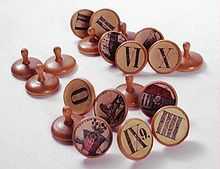Gnav

Gnav is a traditional game that is played with either cards or wooden pieces. Related games are Cuccù, Hexenspiel, Gnaio, Vogelspiel, Cambio (also Campio, Camphio, Camfio, or Kamfio), and Kille.
History of the game

The game originated in 17th century Italy as Cuccu ("cuckoo"), with a deck of 38 cards, but as the game migrated north through Europe in the 18th century the number of cards and the name of the game changed.[citation needed] In Germany, Bavaria, and Austria, for example, it became Hexenspiel ("the Witch game") and Vogelspiel ("The Bird game").[1] By the time that it reached Denmark as Gniao (the miaowing of a cat — "gnao" in Italian), it had 42 cards. This then became Gnav when the game was brought to Norway during the union with Denmark.
The game is first mentioned in Sweden in 1741, as Cambio (Italian for "exchange"). In 1833 this became Kille (probably a distortion of "Harlequin", given the special rules for the Harlequin card in the Swedish version of the game), which became the common form of the game around 1850.[2]
Rules
Each player receives just one card, and play proceeds by turns. At each turn, a player can try to swap a card with a neighbour, the aim being to avoid having the lowest card. Whoever has the lowest card loses 1 life, dropping out of the game when they have no more lives left. The last person in the game wins.
Pieces
Gnav
The wooden pieces, in the piece version of the game, resemble the pawns in chess, with the identity of the piece being written on the base of the piece and thus invisible during play. The deck, in the card version of the game, comprises 42 cards of a single suit, comprising two copies of 21 distinct cards, in the ranking (highest to lowest):
- Gjöken (cuckoo) — a deliberately old-fashioned spelling of "Gjøken"/"Gauken" (Bokmål/Nynorsk)
- Dragonen (dragoon)
- Katten (cat)
- Hesten (horse)
- Huset (house)
- 12
- 11
- 10
- 9
- 8
- 7
- 6
- 5
- 4
- 3
- 2
- 1
- 0
- Narren (Fool)
- Potten (pot)
- Uglen (owl)
Kille
The deck comprises 42 cards of a single suit, comprising two copies of 21 distinct cards, in the ranking (highest to lowest):
- Kuku (cuckoo)
- Husar
- Husu (sow/pig)
- Kavall (horse/knight)
- Värdshus (inn)
- 12
- 11
- 10
- 9
- 8
- 7
- 6
- 5
- 4
- 3
- 2
- 1
- Kransen (wreath)
- Blompottan (flowerpot)
- Blaren (mask/face)
- Harlekin (harlequin) — this does not have a fixed place in the sequence, and its ranking depends from whether it has been dealt or exchanged
Cuccù
The game Cuccù (or Cucco, or Cucu’, or Stu) is considered as one of the oldest game played with cards. One of the first historical document describing the game is dated 10.September.1547 (“Capriccio in laude del Malcontento” written by Luigi Tansillo from Naples). As in Tarot cards, also Cucu’ illustrated cards (10 in total) have an iconographic symbology that was peculiar during the Middle Age. The other 10 cards (numbered from 1 to 10) simply have Roman numbers but with the “four” written IIII instead of IV and the “nine” written VIIII instead of IX. This was a non formal way to write Roman numbers that arose during the Middle Age. The oldest known written regulation dates back to 1717. It was included in the deck of cards produced in Bologna by Giulio Borzaghi. The deck comprises 40 cards, comprising two copies of 20 distinct cards, in the ranking (highest to lowest):
- XV – Cucco (a bird looking as an owl with a crown)
- XIIII – Hai pigliato bragon (a jack with a rose in one hand)
- XIII – Salta (a rampant horse)
- XII – Gnao (a cat)
- XI – Fermatevi alquanto (an inn)
- X
- VIIII
- VIII
- VII
- VI
- V
- IIII
- III
- II
- I
- Nulla (zero)
- Secchia meno di nulla (a bucket)
- Mascherone manco di secchia (mask/face)
- (a rampant lion)
- Matto (a joker, fool) — this does not have a fixed place in the sequence.
In Italy, currently, the game is played with original rules only in two small Abruzzi cities (Campli and Montorio al Vomano) both in Teramo province. Same cards are also used in Brescia and Bergamo provinces but with different rules from the originals.
Hexenspiel
See also
Notes
- "Lugnare Vatten - Kjell Höglund". Retrieved July 1, 2005.
- "Card games in Sweden". Retrieved July 1, 2005. which in turn cites
- A.G.Smith. "The Cambio Packs and the Games played with them II - Hypp, Gnav and Kille". The Playing Card XIX (4): 118–127.
- "Games played with single suited cards". Retrieved July 1, 2005.
- "Card Games: Cuckoo Group". Retrieved July 1, 2005.
- "Remo Rehder Plays Board Games in Norway". Retrieved July 1, 2005.
- Bauer, Günther G.: "Das Salzburger Hexenspiel", in: Homo Ludens. Der Spielende Mensch II (1992), G.G. Bauer (ed.). München & Salzburg: Katzbichler, ISBN 3-87397-334-0, pp. 239–282 (German).
References
- ↑ Roger Tilley A history of playing cards pg. 192 C. N. Potter (1973) ISBN 0-517-50381-6
- ↑ Hugo Kastner Die große Humboldt-enzyklopädie der Kartenspiele pg. 30 Humboldt (2205) ISBN 3-89994-058-X (German)